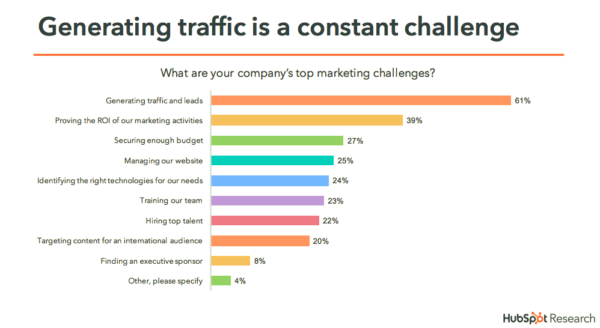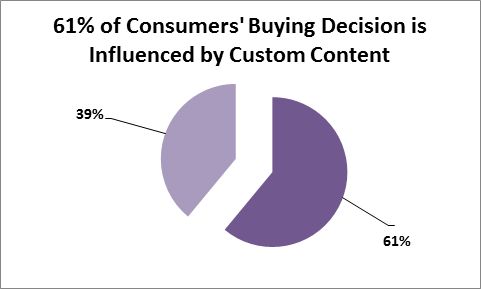Lead generation—it’s the workhorse of any B2B revenue stream. The more effective a brand’s lead gen efforts, the more prospects get converted into paying customers.
We know what you’re thinking… this isn’t exactly breaking news. What might be, however, is the fact that lead generation efforts are one of the biggest obstacles marketers struggle to overcome. According to HubSpot, 61 percent of B2B marketers in 2018 list “generating traffic and leads” as their top challenge.
(Source.)
It makes sense, too. Today, marketers are consistently being asked to generate more leads, faster. As a result, the quality of those leads has started to plummet—leading to wasted time, resources, and effort nurturing and engaging leads that have no intention of converting.
To fix this, marketers need a better lead generation funnel that helps them sift through the large number of prospects at the top of the funnel, identify the most viable leads for sales, and nurture them into paying customers at the end of the funnel.
An integral component of this lead gen funnel? How marketers leverage questions. A lot of content on the subject of lead generation will list off some “must-have” qualifying questions to ask prospects, yet, not many of them focus on the questions the prospects have themselves.
Modern prospects are digitally connected, savvy researchers who take the time to explore their options before making a buying decision. As a result, prospective customers now expect brands to connect them with the resources and opportunities that help them understand a brand’s products or services and how they can help solve the prospect’s problems.
With this in mind, we’ll explain how understanding customer questions can help marketers meet this demand. Additionally, we’ll dive into the ways marketers can identify these questions and put them to work for more effective lead generation.
The Importance of Customer Questions
B2B lead generation revolves around how well marketers understand their target audience. Demand gen and marketing teams that know the unique needs, interests, and pain points of their prospects will be best equipped to deliver the personalization B2B prospects now demand. What’s more, it now takes between six to eight touchpoints just to turn a prospect into sales qualified lead—further emphasizing how important it is to be able to know where, why, and how to engage prospects.
In order to understand how to best engage prospects and connect them with the different kinds of content and interactions that help move them down the sales funnel, marketers need to understand what their prospects want. More specifically, they need to know what their prospects want to learn.
By asking prospects about their unique questions, marketers will be able to better align their efforts to drive engagement, influence prospects, and move them down the funnel. With custom content influencing 61 percent of consumers’ buying decisions, having better insights into opportunities for personalized content and engagement can make all the difference.
(Source.)
Additionally, having the answers to prospects’ questions goes a long way toward differentiating one brand from another. Take these two scenarios for example:
Competitor one understands the main questions their target audiences have regarding their products or services. They then use those insights to tailor their marketing efforts to speak directly to those customers. At the top of the funnel, they answer high-level questions. As leads progress down the funnel, content begins to align with the increasingly specific questions those leads have.
Competitor two doesn’t know what their prospects want. Their content and marketing efforts are geared toward general topics they think their audience may find useful, but these efforts aren’t tailored to anything specific. As a result, prospects find it harder to get the information they find pertinent and will often visit outside sources to educate themselves.
Can you guess which competitor a prospective customer is likely going to buy from? We thought so.
Simply put, by paying attention to the questions customers ask, marketers can provide the right engagements that connect prospects with the right tools and resources to help them reach a buying decision faster. What’s more, they’ll be able to identify the questions prospects ask when they’re interested in converting—valuable information that can help separate the good leads from the bad.
With that said, let’s take a look at how marketers can leverage customer questions:
Identifying Customer Questions for Better Marketing Efforts
In order to of harness the power of customer questions for better lead generation efforts, it helps to understand what kind of questions are being asked. With this in mind, marketers should consider using the following tips and tricks when trying to learn what their customers are asking:
Explore Questions from Your Target Audience:
Marketers have a wide range of tools and resources they can use to better understand the questions driving their target audience across the sales cycle. For example, marketers can look at Quora questions or topics related to their product or brand. Additionally, LinkedIn groups, social media, industry publication, and even your own site’s site search data all provide clues as to the common questions prospects want to know.
Ask the Sales Team for Input:
As we’ve mentioned before, aligned sales and marketing efforts can go a long way toward generating more revenue. Since sales teams interact with prospects one-on-one, they can provide insights that can be leveraged by marketers for better lead gen efforts. For example, say sales has noticed that the majority of prospects are interested in how a product can increase their organizations efficiency. From there, this question can be answered at a high-level for top-funnel prospects and more specifically as prospects move closer to conversion.
Ask Your Current Customers:
If there’s anyone that understands what prospects want to know, it’s the customers that have been there and done that. In other words, they can provide valuable insights when asked about the questions and answers that helped convince them to convert, as well as the questions they have while using a product or service.
Now that we’ve identified some strategies for identifying customer questions, let’s dive into how these questions can be used for better lead generation efforts.
Incorporating Customer Questions into Marketing Efforts
To keep the funnel packed with high-quality leads, marketers need to leverage customer questions to guide the content, resources, and engagements they provide to their prospects.
Customers have access to tons of content related to your (and your competitors’) products and services and use that abundance of information to make an informed buying decision. Considering half of all B2B buyers decide whether or not they’ll make a purchase before talking to sales, the impact of providing relevant marketing engagements has never been so important.
Being able to answer the right question at the right time can set your organization apart. By understanding the questions most pertinent to prospective customers, marketers will be able to better align their qualifying questions with their prospects. Marketers can leverage the insights gained from customer questions using interactive tools like polls, calculators, and quizzes.
These assets make B2B marketing easier on two fronts. First, they provide opportunities for prospects to engage with the potential problems, interests, and needs most relevant to them. Second, they can directly answer prospect questions the moment they have them with a series of personalized engagements.
Final Thoughts
Lead generation can make or break the success of marketing efforts. In order to make sure a brand’s proverbial cup runneth over with quality leads, marketers need to understand what their prospects want to know. Moreover, they need to quickly provide those prospects with answers.
Simply put, if marketers don’t understand their customers’ questions – and take concrete steps to address them — their lead generation efforts will lag behind the competitors that do.
If you’re interested in ensuring that you can understand and answer your customers’ questions, consider taking a look at these interactive content examples that can help you get the most out of your demand gen efforts.

